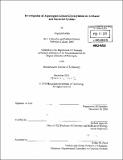| dc.contributor.advisor | Barbara Imperiali. | en_US |
| dc.contributor.author | Larkin, Angelyn (Angelyn Kathryne) | en_US |
| dc.contributor.other | Massachusetts Institute of Technology. Dept. of Chemistry. | en_US |
| dc.date.accessioned | 2011-05-09T15:26:01Z | |
| dc.date.available | 2011-05-09T15:26:01Z | |
| dc.date.copyright | 2010 | en_US |
| dc.date.issued | 2011 | en_US |
| dc.identifier.uri | http://hdl.handle.net/1721.1/62725 | |
| dc.description | Thesis (Ph. D.)--Massachusetts Institute of Technology, Dept. of Chemistry, February 2011. | en_US |
| dc.description | Vita. Cataloged from PDF version of thesis. | en_US |
| dc.description | Includes bibliographical references. | en_US |
| dc.description.abstract | Asparagine-linked protein glycosylation entails the stepwise assembly of an oligosaccharide onto a polyisoprenyl diphosphate carrier, followed by the en bloc transfer of the glycan onto acceptor proteins by oligosaccharyl transferase (OTase). It is now clear that this N-linked protein modification catalyzed by OTases is conserved in all three kingdoms of life. In contrast to eukaryotic OTases, which are multimeric complexes made up of several membrane-spanning proteins, bacterial and archaeal OTases instead appear to be composed of just a single membrane-bound subunit, offering a more tractable system for detailed biochemical characterization. Although significant progress has been made with the bacterial OTase PglB from Campylobacterjejuni, problems with low protein expression yields and poor stability have complicated in depth study. In order to identify a more suitable OTase candidate, a selection of archaeal OTases was screened for heterologous expression levels in Escherichia coli, and it was determined that the homolog from the methanogen Methanococcus voltae possessed the best protein expression profile, indicating a 100-fold improvement over PglB. In an effort to generate a substrate to probe the function of the M voltae OTase, we required a robust synthesis of the highly modified UDP-GlcNAc(3NAc)A and thus turned to the Wbp pathway from the opportunistic pathogen Pseudomonas aeruginosa. Early genetic studies suggested that P. aeruginosa produces UDP-GlcNAc(3NAc)A as a precursor to ManNAc(3NAc)A, a carbohydrate found in the O-antigen of the lipopolysaccharide of the organism. Using a combination of protein biochemistry and NMR spectroscopy, three enzymes (WbpB, WbpE, and WbpD) were confirmed to be responsible for the biosynthesis of UDPGlcNAc( 3NAc)A. It is shown that WbpB and WbpE are a dehydrogenase/aminotransferase pair that converts UDP-GlcNAcA to UDP-GIcNAc(3NH 2)A in a coupled reaction via a unique NAD* recycling pathway. In addition, the X-ray crystal structure of WbpE was solved in complex with its PLP cofactor and UDP-GlcNAc(3NH 2)A product as the external aldimine. With UDP-GlcNAc(3NAc)A in hand, preliminary steps towards completion of the desired dolichyl-linked substrate for the study of the M. voltae OTase are described. Finally, biochemical studies were undertaken in an attempt to inhibit the C. jejuni OTase, PglB. To this end, a panel of isosteric peptides was synthesized to identify possible PglB inhibitors. In addition, treatment of PglB with residue-specific alkylating agents coupled with site-directed mutagenesis revealed a key histidine residue that may play an important role in enzyme catalysis. Taken together, these studies offer insight into long-standing questions about the mechanism of oligosaccharide transfer. | en_US |
| dc.description.statementofresponsibility | by Angelyn Larkin. | en_US |
| dc.format.extent | 299 p. | en_US |
| dc.language.iso | eng | en_US |
| dc.publisher | Massachusetts Institute of Technology | en_US |
| dc.rights | M.I.T. theses are protected by
copyright. They may be viewed from this source for any purpose, but
reproduction or distribution in any format is prohibited without written
permission. See provided URL for inquiries about permission. | en_US |
| dc.rights.uri | http://dspace.mit.edu/handle/1721.1/7582 | en_US |
| dc.subject | Chemistry. | en_US |
| dc.title | Investigation of asparagine-linked glycosylation in archaeal and bacterial systems | en_US |
| dc.type | Thesis | en_US |
| dc.description.degree | Ph.D. | en_US |
| dc.contributor.department | Massachusetts Institute of Technology. Department of Chemistry | |
| dc.identifier.oclc | 716478763 | en_US |

